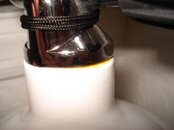UB
Contributor
After the second fill of my new steel Faber tank, I noticed a brownish film around the tank stem (where the valve is screwed in, refer to pic).
I asked the dive shop as soon as I noticed it (which was right after they filled my tank) what it was and they indicated that it was just oil or lubricant used to help screw in the valve. I was able to easily wipe it off (I left some on in order to take a picture to help ensure that it wasn't something wrong with the tank)
I filled it several times since and have not seen it appear again.
Since the tank is steel I am concerned about rust. It passed a visual about 1 month before.
Any feedback is appreciated.
Thank you
I asked the dive shop as soon as I noticed it (which was right after they filled my tank) what it was and they indicated that it was just oil or lubricant used to help screw in the valve. I was able to easily wipe it off (I left some on in order to take a picture to help ensure that it wasn't something wrong with the tank)
I filled it several times since and have not seen it appear again.
Since the tank is steel I am concerned about rust. It passed a visual about 1 month before.
Any feedback is appreciated.
Thank you




